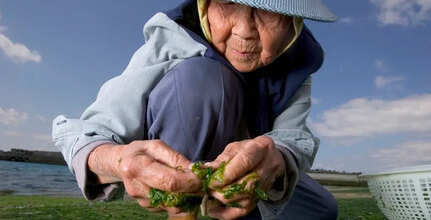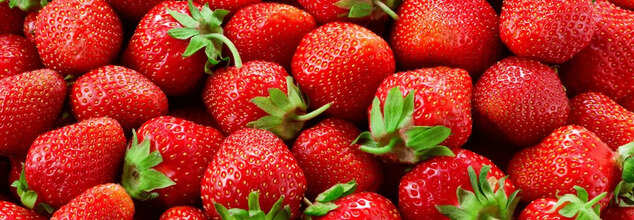- Health Conditions A-Z
- Health & Wellness
- Nutrition
- Fitness
- Health News
- Ayurveda
- Videos
- Medicine A-Z
- Parenting
- Web Stories
Blue Zones Diets: What the World’s Longest-Livers Eat

Blue Zone Diet (Credit: Blue Zones)
Blue Zones are geographical regions with a longer life expectancy and lower rates of chronic diseases. Identified by American explorer Dan Buettner, these "longevity centres" house people who follow specific diet and lifestyle practices that help them live past 100 years.
The five Blue Zones are:
- Okinawa, Japan
- Sardinia, Italy
- Nicoya Peninsula, Costa Rica
- Ikaria, Greece
- Loma Linda, California, USA
Specific Dietary Practices Followed In Blue Zones
1. Okinawa, JapanThe Okinawan diet is rich in vegetables, tofu, and sweet potatoes. They practice "Hara Hachi Bu," eating until they’re 80% full, which helps prevent overeating. The diet is low in calories and high in nutrients, with an emphasis on plant-based foods like bitter melon, goya, and seaweed.
2. Sardinia, Italy
In Sardinia, the diet is rooted in whole grains, beans, vegetables, and fruits, with moderate consumption of wine. They consume plenty of fava beans, chickpeas, and barley, which are packed with fibre and protein. Meat is eaten sparingly, often as a side dish rather than the main course.
3. Nicoya Peninsula, Costa Rica
Nicoyans enjoy a diet rich in beans, corn, and squash, known as the “three sisters.” Their meals are simple but nutrient-dense, with a strong reliance on plant-based foods. They also consume a lot of tropical fruits, providing antioxidants and vitamins that support longevity.
4. Ikaria, Greece
The Ikarian diet is a variation of the Mediterranean diet, focusing on vegetables, whole grains, and olive oil. Ikarians consume plenty of wild greens, herbs, and legumes. Their diet is also low in processed foods and sugars, which helps in maintaining heart health and reducing inflammation.
5. Loma Linda, California, USA
Loma Linda is home to a community of Seventh-day Adventists who follow a plant-based diet. Their diet emphasizes whole grains, nuts, fruits, and vegetables while avoiding meat and processed foods. This diet, combined with a strong sense of community and faith, contributes to their longevity.
Each Blue Zone diet is unique but shares common themes: a plant-based focus, moderate food intake, and the consumption of natural, whole foods. These dietary practices, along with an active lifestyle and strong social connections, are key to the remarkable longevity observed in these regions.
Chemicals Found In Sugar-free Desserts May Impair Brain Function, Study Finds

Credit: Canva
A common sugar substitute found in "sugar-free" drinks and desserts may be impairing your brain function. A new study presented at the American Physiology Summit indicated that erythritol, found in many desserts and drinks, may impair blood vessel health by disrupting the brain's production of nitric oxide. Cells exposed to typical erythritol levels showed increased oxidative stress and reduced nitric oxide, potentially impairing blood flow.
It is pertinent to know that the human brain uses Nitric Oxide as a neurotransmitter that helps regulate blood flow as well as influences neuronal development. The new study explains earlier research linking erythritol to stroke and heart attacks.
How Was The New Study Performed?
In a new study, researchers treated human cerebral microvascular endothelial cells—cells from the tiny blood vessels in the brain—with erythritol. They found that the cells exposed to the amount of sweetener in one beverage serving had higher levels of oxidative (cellular) stress. These cells also produced less nitric oxide, a compound that helps blood vessels dilate. Reduced nitric oxide levels can impair vasodilation, impair blood flow, and may increase the risk of heart attack and stroke.
"While erythritol is widely used in sugar-free products marketed as healthier alternatives, more research is needed to fully understand its impact on vascular health," said Auburn Berry, a graduate student at the University of Colorado Boulder and first author of the study. "In general, people should be conscious of the amount of erythritol they are consuming daily," added.
Here Are Products That Have Erythritol
Erythritol is a low-calorie sugar substitute found in many sugar-free products, including energy drinks, snack foods and protein bars. Like other sugar alcohols, erythritol is popular because it does not affect blood glucose and insulin levels as much as sugar. Here is a list of products that may use this compound as one of its ingredients.
1. Sugar-Free or Keto Snacks
Keto-friendly protein bars (e.g., Quest, Perfect Keto)
Low-carb cookies and brownies (e.g., Lenny & Larry’s Keto Cookies)
Keto peanut butter cups and chocolates (e.g., Lily's, ChocZero)
2. Beverages
Flavored water (e.g., VitaminWater Zero, Bai Antioxidant Drinks)
Zero-calorie energy drinks (e.g., Monster Ultra, Zevia)
Sugar-free iced teas and lemonades
3. Gum and Mints
Sugar-free chewing gum (e.g., Trident, Orbit)
Breath mints (e.g., Altoids Smalls Sugar-Free, Ice Breakers)
4. Sugar-Free Candy and Chocolates
Gummy bears, licorice, or hard candies labeled “sugar-free”
Brands: SmartSweets, Russell Stover Sugar-Free
5. Baking Products
Erythritol sweeteners (e.g., Swerve, Lakanto, PureVia)
Baking mixes like low-carb pancake or brownie mixes
6. Ice Cream and Frozen Desserts
Brands like Rebel, Enlightened, and Halo Top Keto series use erythritol as a sweetener
7. Meal Replacements and Protein Powders
Many low-carb shakes or protein powders include erythritol to keep sugar content low
8. Yogurt and Dairy Alternatives
Low-sugar Greek yogurts or keto-friendly yogurt alternatives.
Struggling To Maintain Fluid Balance—5 Fruits That Help Replenish Electrolytes

Credit: Canva
Electrolytes are minerals with an electrical charge, essential for various cellular functions like muscle contraction and maintaining fluid balance during exercise. Adequate electrolyte intake can help prevent dehydration and muscle cramps and support cognitive function and performance. These minerals—sodium, potassium, magnesium, and calcium—are lost through sweat and urine, making it important to replenish them throughout the day, especially after a run.
Among runners, low sodium levels are often a bigger concern than high levels. Sodium is the electrolyte most commonly lost in sweat, explains registered dietitian Kylee Van Horn. “It plays a key role in both muscle contraction, fluid balance, and the body’s ability to utilize glucose (sugars) in the small intestine,” she says. “It works alongside chloride and potassium to maintain fluid balance.”
Hyponatremia, or dangerously low sodium levels in the blood, typically results from too much fluid relative to sodium. This condition—exercise-associated hyponatremia (EAH)—can develop during or after strenuous physical activity and may lead to serious health issues.
Potassium works together with sodium and is vital for muscle contraction, blood pressure regulation, and preventing cramps. The recommended daily intake for potassium is around 4,700 milligrams.
“Magnesium and calcium support muscle contraction and energy production but are lost in smaller quantities through sweat,” Van Horn adds.
Though many people turn to electrolyte drinks, gels, or tablets, it’s easy to overlook that plenty of whole foods are rich in electrolytes. Moreover, many commercial sports drinks may contain only sodium and come with added sugars or other unwanted ingredients, while missing out on other vital electrolytes.
A study published in Nutrients suggests that hydrating foods can make up about 20% of our total water intake. Raw fruits and vegetables have the highest water content and often contain small amounts of electrolytes. These foods also provide carbohydrates, which are necessary for replenishing muscle glycogen after a workout. That’s all the more reason to aim for at least five servings of fruits and vegetables daily.
5 Fruits That Help Replenish Electrolytes
Adding a variety of fruits rich in electrolytes to your daily diet can enhance hydration, boost recovery, and support overall performance. Here are five seasonal options you can find at your local market:
1. Strawberries
Best known for their vitamin C content, strawberries also contain potassium. One cup provides about 5% of the daily recommended intake. Blend them into smoothies, add them to oatmeal, or enjoy them on their own. Strawberries may also ease GI distress thanks to their anti-inflammatory effects on the colon.
2. Cherries
Tart cherries support muscle recovery and reduce inflammation. One cup offers 270–300 mg of potassium along with small amounts of calcium, magnesium, and sodium.
3. Bananas
A favourite among runners, bananas offer 422 mg of potassium per medium fruit, plus magnesium. Pairing them with salted peanut butter can add sodium and improve post-run recovery.
4. Mangoes
Rich in vitamin C and antioxidants, a cup of diced mango provides nearly 7% of your daily potassium needs and some magnesium. Blend with calcium-rich yoghurt for an electrolyte-packed snack.
5. Watermelons
Composed of 92% water, watermelons are hydrating and contain potassium and antioxidants like vitamins A and C. Add a pinch of salt to boost both flavour and sodium intake.
Ozempic Without The Side Effects? Try This Drug-Free Method

Credits: Canva
Semaglutide -based drugs like Ozempic and Wegovy have surged in popularity for their ability to suppress hunger and aid in quick weight loss but with the buzz, more and more people are still hesitant about medication use long-term—particularly with the gastrointestinal side effects and price tag that come with most of these injections. What if you could mimic some of the processes of these medications naturally without ever setting foot in a pharmacy?
Science today reveals that it's possible. Through the power of nutrition, timing, and meal form, you can boost your body's own levels of GLP-1 (glucagon-like peptide-1)—the hormone semaglutides are engineered to copy. No diet or habit can duplicate the pharmacological effect of Ozempic, but the correct lifestyle changes can have significant, long-term weight loss—without the risks.
What's Body's Natural "Fullness" Signal?
GLP-1 is a gut hormone that signals fullness, delays gastric emptying, and regulates insulin. How semaglutide drugs do this is by increasing levels of GLP-1 and preventing it from being broken down, prolonging that feeling of fullness from a matter of minutes to a few days. That's what triggers the dramatic reduction in appetite experienced with Ozempic.
But recent research shows that GLP-1 can even be boosted by natural methods—namely, with focused food selection, attentive consumption, and timing strategies.
What Are The Nutrients That Naturally Increase GLP-1?
At the center of any pharmaceutical-free weight reduction technique is food. But calories alone—certain nutrients direct the body's endocrine reactions, including GLP-1.
Fibre: Richly found in beans, vegetables, whole grains, nuts, and seeds, fibre is fermented within the gut by resident beneficial bacteria to release short-chain fatty acids that induce the release of GLP-1. Diets rich in fibre are always linked with weight loss—even when calories aren't limited.
Monounsaturated Fats: Olive oil, avocado, and nuts such as pistachios contain high levels of monounsaturated fats, which have been proven to raise GLP-1. Even a small trial comparing bread with olive oil to bread with butter showed higher levels of the hormone with the olive oil combination. Even combining carbs with any source of fat (such as cheese) increases GLP-1 over consuming carbs on their own.
Whole Foods Combinations: Placing avocado on a typical bagel breakfast or adding fibre-dense nuts as a snack can provide an GLP-1 kick. Foods that pair fibre and healthy fat—such as pistachios—are particularly potent.
Why Timing and Order of Meals Matter?
The tale doesn't end with ingredients—it continues to behavior. How, when, and in what order you eat is an important contributor to hormonal balance.
Meal Order: Beginning meals with protein or vegetables first, then eating carbs, results in more GLP-1 release. This easy adjustment—protein or greens first—is a key that can stabilize blood sugar and promote feelings of fullness.
Circadian Rhythms: GLP-1, as with all hormones, has a biological clock. Breakfast meals release much more GLP-1 than dinner meals. Eating a high-calorie breakfast results in greater satiety and improved metabolic effects compared to a calorie-dense dinner. Front-loading your calorie intake—eating "breakfast like a king"—isn't simply an old maxim; it's science.
Chewing and Rate of Eating: The chewing act might be more significant than you realize. In one study, eating chopped cabbage (one needed to chew it) resulted in higher GLP-1 levels than having the same vegetable as a purée. Further, eating a dessert, such as ice cream, at a slow rate over 30 minutes generated higher GLP-1 levels than rapid consumption in five. Eating more slowly can transmit stronger "full" messages to the brain.
How Natural GLP-1 Levels Compare to Medications?
It is worth noting the limitations of food intervention. Semaglutide drugs such as Ozempic raise GLP-1 levels to about 65 nanograms per millilitre of blood—more than a thousand times the 59 picograms induced by even the healthiest foods.
But weight loss is not the sole indicator of success. The Mediterranean diet that naturally increases GLP-1 through olive oil, nuts, vegetables, and lean meats has been proven to decrease the risk of heart disease by 30%. Semaglutide drugs, on the other hand, decrease cardiac risk by 20%. For overall health benefits, food trumps medicine.
Drug-Free Blueprint for Weight Loss
If you want a drug-free weight management that is in harmony with your body's natural rhythms and biochemistry, here are things worth considering incorporating into your lifestyle:
- Eat breakfast as the biggest meal of the day.
- Eat at least one high-fibre food per meal.
- Emphasize healthy fats, particularly olive oil, avocado, and nuts.
- Start meals with vegetables or proteins first, and then carbohydrates.
- Munch slowly and thoroughly.
- Space out meals to coincide with your body's circadian rhythm—eat sooner, not later.
- Add in snacks such as pistachios or almonds, which pair fibre with healthy fat.
These practices won't provide magic in a single night, but they provide long-term weight control and metabolic wellness without side effects, addiction, or prescription renewals.
© 2024 Bennett, Coleman & Company Limited

